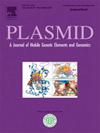miRNA heterologous production in bacteria: A systematic review focusing on the choice of plasmid features and bacterial/prokaryotic microfactory
IF 1.8
4区 生物学
Q3 GENETICS & HEREDITY
引用次数: 0
Abstract
Bacteria, the primary microorganisms used for industrial molecule production, do not naturally generate miRNAs. This study aims to systematically review current literature on miRNA expression systems in bacteria and address three key questions: (1) Which microorganism is most efficient for heterologous miRNA production? (2) What essential elements should be included in a plasmid construction to optimize miRNA expression? (3) Which commercial plasmid is most used for miRNA expression? Initially, 832 studies were identified across three databases, with fifteen included in this review. Three species—Escherichia coli, Salmonella typhimurium, and Rhodovulum sulfidophilum—were found as host organisms for recombinant miRNA expression. A total of 78 miRNAs were identified, out of which 75 were produced in E. coli, one in R. sulfidophilum (miR-29b), and two in S. typhimurium (mi-INHA and miRNA CCL22). Among gram-negative bacteria, R. sulfidophilum emerged as an efficient platform for heterologous production, thanks to features like nucleic acid secretion, RNase non-secretion, and seawater cultivation capability. However, E. coli remains the widely recognized model for large-scale miRNA production in biotechnology market. Regarding plasmids for miRNA expression in bacteria, those with an lpp promoter and multiple cloning sites appear to be the most suitable due to their robust expression cassette. The reengineering of recombinant constructs holds potential, as improvements in construct characteristics maximize the expression of desired molecules. The utilization of recombinant bacteria as platforms for producing new molecules is a widely used approach, with a focus on miRNAs expression for therapeutic contexts.

细菌中的 miRNA 异源生产:系统综述,重点关注质粒特征选择和细菌/原核生物微工厂。
细菌是用于工业分子生产的主要微生物,但不会自然产生 miRNA。本研究旨在系统回顾目前有关细菌中 miRNA 表达系统的文献,并解决三个关键问题:(1)哪种微生物生产异源 miRNA 的效率最高?(2) 质粒构建应包含哪些基本要素以优化 miRNA 表达?(3) 哪种商业质粒最适用于 miRNA 表达?最初,在三个数据库中发现了 832 项研究,其中 15 项纳入了本综述。发现大肠埃希氏菌、鼠伤寒沙门氏菌和嗜硫罗氏菌这三个物种是重组 miRNA 表达的宿主生物。共鉴定出 78 种 miRNA,其中 75 种产生于大肠杆菌,一种产生于嗜硫雷杆菌(miR-29b),两种产生于伤寒沙门氏菌(mi-INHA 和 miRNA CCL22)。在革兰氏阴性菌中,嗜硫杆菌因其分泌核酸、不分泌 RNase 和海水培养能力等特点而成为异源生产的高效平台。不过,大肠杆菌仍是生物技术市场上公认的大规模 miRNA 生产模式。关于在细菌中表达 miRNA 的质粒,带有 lpp 启动子和多个克隆位点的质粒似乎是最合适的,因为它们具有强大的表达盒。重组构建体的再设计具有潜力,因为构建体特性的改进可最大限度地表达所需分子。利用重组细菌作为生产新分子的平台是一种广泛使用的方法,重点是用于治疗的 miRNAs 表达。
本文章由计算机程序翻译,如有差异,请以英文原文为准。
求助全文
约1分钟内获得全文
求助全文
来源期刊

Plasmid
生物-遗传学
CiteScore
4.70
自引率
3.80%
发文量
21
审稿时长
53 days
期刊介绍:
Plasmid publishes original research on genetic elements in all kingdoms of life with emphasis on maintenance, transmission and evolution of extrachromosomal elements. Objects of interest include plasmids, bacteriophages, mobile genetic elements, organelle DNA, and genomic and pathogenicity islands.
 求助内容:
求助内容: 应助结果提醒方式:
应助结果提醒方式:


